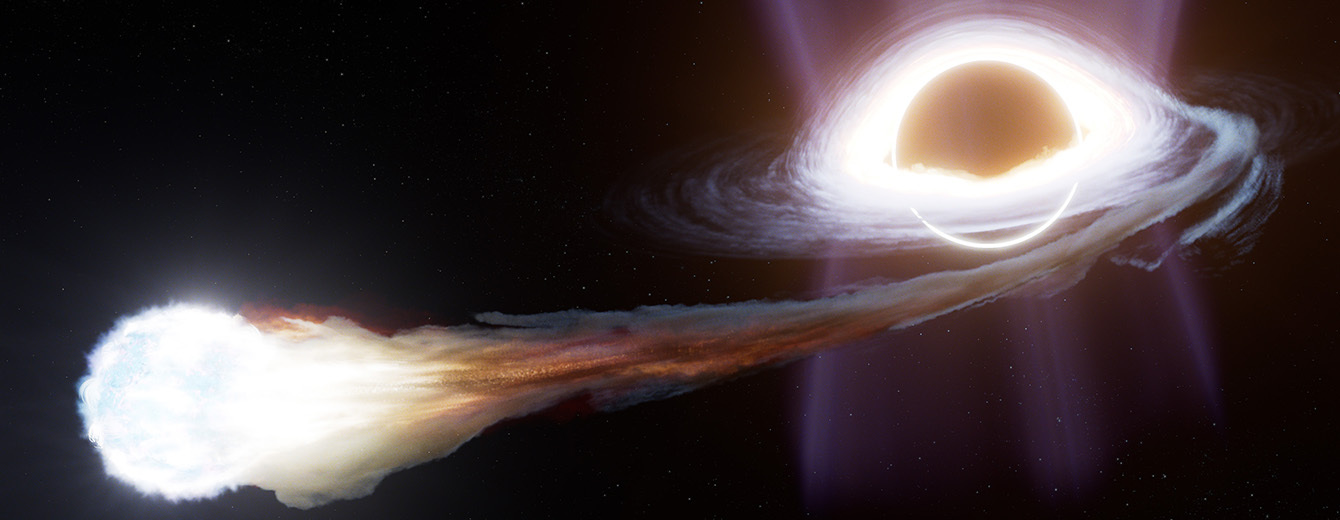13.05.2024

Summary
Tidal disruption events offer an opportunity to locate the elusive stars.
The universe’s earliest stars, known as Population III stars, are notoriously hard to detect with even our most powerful observatories due to their great distance and short lifetime. However, using the wide field of view and rapid survey speed of NASA’s upcoming Nancy Grace Roman Space Telescope, astronomers hope to spot dozens of them as they are shredded by massive black holes.
The first stars to form in the universe were very different from our Sun. Known to astronomers (somewhat paradoxically) as Population III, or Pop III, stars, they were made almost entirely of hydrogen and helium. They are believed to have been much larger, hotter, and more massive than our Sun. As a result, Pop III stars use their fuel more quickly and have shorter lifespans.
Pop III stars, which came about in the first few hundred million years after the big bang, are crucial in understanding the development of the universe. These stars were the nuclear furnaces where the first elements heavier than helium, which astronomers call metals, were generated, and ultimately are the reason for the complex systems of galaxies in the current universe.
No Pop III stars are found around us today, so to learn about them we must look back to the early universe. NASA’s Nancy Grace Roman Space Telescope will provide a panoramic field of view 200 times larger than the infrared view of the sky from NASA’s Hubble Space Telescope and survey the sky 1,000 times faster. As a result, Roman may be a key tool for helping astronomers see this rare first generation of stars after it launches by May 2027.
Shredded Stars
The new approach will not seek intact stars. Instead, astronomers will hunt for signs of Pop III stars that have been shredded by black holes, creating a bright and energetic phenomenon known as a tidal disruption event (TDE).
If a star moves close enough to a black hole, the star will experience gravitational tides strong enough to completely disrupt it. Some of the material from the disrupted star then collects into an accretion disk, where complex physical processes cause it to glow brightly enough to be seen from billions of light-years away.
"Since we know that black holes likely exist at these early epochs, catching them as they’re devouring these first stars might offer us the best shot to indirectly detect Pop III stars," noted Priyamvada Natarajan of Yale University, a co-author of the study.
TDEs generate light in many wavelengths, including X-ray, radio, ultraviolet (UV), and optical light. The further we look into the early universe, where these early stars primarily reside, the more the optical and UV light is redshifted, or stretched by the expanding universe, into near-infrared wavelengths visible to Roman.
Not only does the wavelength of light stretch – so does the observed timescale of the TDE. Like an exploding star or supernova, a TDE is a transient event that increases quickly in brightness and then gradually decreases over time. But due to the large redshift of these events, a Pop III TDE would brighten over the course of hundreds to thousands of days, while its decline would last more than a decade.
“The evolution timescales of Pop III TDEs are very long, which is one feature that could distinguish a Pop III TDE from other transients including supernovas and TDEs of current-generation stars like our Sun,” said Rudrani Kar Chowdhury, postdoctoral fellow of the University of Hong Kong and first author of the study.
“Since they last for a longer time, a Pop III TDE might be easier to detect, but it might be harder to identify as a transient,” added co-author Jane Dai, professor of astrophysics at the University of Hong Kong. “Scientists would need to design the right survey strategy.”
A Coordinated Hunt
While NASA’s James Webb Space Telescope is powerful enough to detect and study TDEs in the early universe, its field of view is too small to make it an efficient TDE hunter. Of Roman’s core community surveys, the most promising for finding TDEs is the High Latitude Wide Area survey, which aims to cover approximately 2,000 square degrees of the sky outside of the plane of our galaxy.
“Roman can go very deep and yet cover a very big area of the sky. That's what's needed to detect a meaningful sample of these TDEs,” said Dai.
Webb would be useful for follow-up observations, however, particularly with its suite of spectroscopic tools. Once Roman detects these TDEs, Webb’s instruments could identify if any metals are present.
“Since these stars are only made up of hydrogen and helium, we will not see any metal lines in the spectrum of objects, whereas in the spectra of TDEs from regular stars we can see various metal lines,” Kar Chowdhury noted.
With this proposed strategy for identifying Pop III stars, there’s an opportunity to explore more of the universe’s mysteries, opening up numerous opportunities to better understand not only the early universe, but also galaxies closer to home.
This research has been published in the Astrophysical Journal Letters.
The Nancy Grace Roman Space Telescope is managed at NASA’s Goddard Space Flight Center in Greenbelt, Maryland, with participation by NASA's Jet Propulsion Laboratory and Caltech/IPAC in Southern California, the Space Telescope Science Institute in Baltimore, and a science team comprising scientists from various research institutions. The primary industrial partners are BAE Systems, Inc. in Boulder, Colorado; L3Harris Technologies in Melbourne, Florida; and Teledyne Scientific & Imaging in Thousand Oaks, California.
